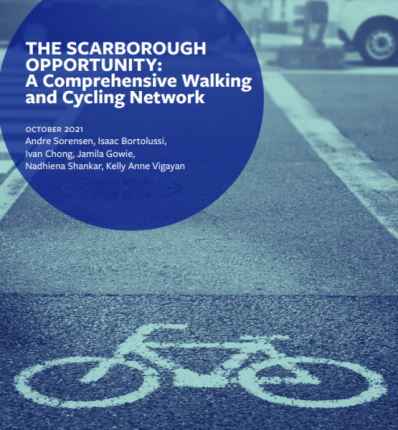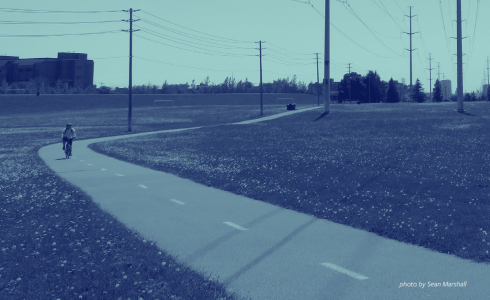The team

This project and report was inspired by the excellent work done by students during the Winter of 2021 in the Department of Human Georgraphy: City Studies class “CITD12: Planning and Building Public Spaces in Toronto” taught by Professor Andre Sorensen. The five top students in the class were invited to participate in the research for and writing of this report during the period May–July 2021. It is dedicated to all University of Toronto Scarborough (UTSC) students who are working to make Scarborough a better and more sustainable place to live and work.
Team leader: Andre Sorensen.
UTSC Students team: Isaac Bortolussi, Ivan Chong, Jamila Gowie, Nadhiena Shankar, and Kelly Anne Vigayan
Advisory committee: Brendan Agnew-Iler, Nancy Smith Lea, Marvin Macaraig, Dylan Reid, and Kevin Rupasinghe
The proposal and our report

The City of Toronto has excellent policies for active transportation, complete streets, and pedestrian/cyclist safety. A goal of the City’s TransformTO climate change action strategy is to ensure that by 2050 75% of trips of less than 5km will be walked or cycled, and the Official Plan aims to have cycling infrastructure available within 1km of every resident in the city. Toronto’s Vision Zero 2.0 framework promises to ensure a safer experience for all road users regardless of age and abilities, to encourage active and sustainable transportation, and to improve the public realm, guided by policy approaches outlined in the Toronto Complete Street Guidelines.
Although the City is working to enable active transportation, there has consistently been a focus on downtown areas when building new infrastructure. This report shows that the City’s record on building cycling facilities in Scarborough has been an abject failure, with almost zero progress in Scarborough since 2016 despite significant achievements elsewhere in the city. The report proposes a comprehensive active transportation network for Scarborough at the scale necessary to achieve existing City of Toronto policy targets. The suggestion is not that this is the only possible network, but that without a long-term plan for a comprehensive network, Toronto is unlikely to be able to significantly improve conditions for active transportation. It is past time to elevate our ambition and to transform Scarborough into a walkable, bikeable, and more livable place.
See our full report here
Recommendations

We call the City of Toronto to:
• Develop and implement a long-term plan for an active tranportation network throughout Scarborough. The current piecemeal approach is simply not working.
• Implement measurable targets for increasing the share of trips taken by walking, cycling, and public transit, to be reviewed every five years until 2050.
• Identify all major obstacles to network connectivity and develop strategies to overcome them to ensure walking and cycling networks in Scarborough are connected.
• Greatly expand and improve off-road cycling and walking networks and establish improved connections between on-road and off-road facilities.
• Plan for redevelopment and intensification that prioritizes active transportation network construction and the creation of mobility hubs and destinations within walking and cycling distance of all Scarborough residents.
• Implement strategies to encourage walking and cycling to all schools in Scarborough
• Direct Toronto Bike Share to develop a plan to roll out Bike Share stations throughout Scarborough, starting with Major Station Areas and activity hotspots – to be completed by 2030
• Design and build, or upgrade, bicycle parking facilities for all current and future TTC Subway and GO stations in Scarborough.